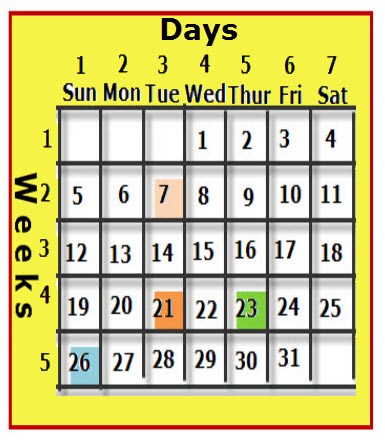Hello,
In our last post we learned how to add weeks and days together. Today we are going to learn how to subtract weeks and days. It is basically the opposite of adding weeks and days. To add weeks and days, we added the weeks and days together, and then we subtracted 7 from the number of days if it was greater than or equal to 7, and then we increased the weeks by 1. We would repeat this process if the days were still 7 or greater.
For subtraction we are going to follow these steps:
1.) Subtract the number of weeks from one another and then subtract the number of days from one another; first, you must check if the second step holds:
2.) If the number of days is less than what you originally started with, you must subtract 1 from the original number of weeks, and then add 7 to the original amount of days.
3.) Once again, subtract the weeks and days.
Examples:
1.) 6 weeks, 8 days - 5 weeks, 3 days = ?
2.) 5 weeks, 4 days - 3 weeks, 9 days = ?
3.) 7 weeks, 2 days - 2 weeks, 6 days = ?
Solutions:
1.) Since the number of days being subtracted (3) is less than the original days (8), we do not need to worry about our steps. So, we subtract normally. 6 weeks - 5 weeks = 1 week. 8 days - 3 days = 5 days. So, our final answer is 1 week, 5 days.
2.) Since the number of days being subtracted (9) is greater than the original amount of days (4), we must follow our steps above. First, we must subtract 1 from our original amount of weeks, which was 5. So, now we have 4 weeks. Now, we add 7 to our original amount of days (4). 4 days + 7 days = 11 days. Now, we can proceed with subtracting. 4 weeks - 3 weeks = 1 week. 11 days - 9 days = 2 days. So, our final answer is 1 week and 2 days.
3.) Since our number of days that we are subtracting (6) is greater than our original amount of days (2), we must subtract 1 from our original amount of weeks (7-1 = 6 weeks). Then, we must add 7 to our original amount of days (2 + 7 = 9 days). Now, subtract normally. 6 weeks - 2 weeks = 4 weeks. 9 days - 6 days = 3 days. So, our final answer is 4 weeks, 3 days.
It is confusing at first, but once you practice, I know you'll be able to do it!
The following are links that reiterate how to subtract weeks and days, which will hopefully help you:
1.) How to subtract weeks and days:explanation and example
2.) Subtract weeks and days to a date calendar













